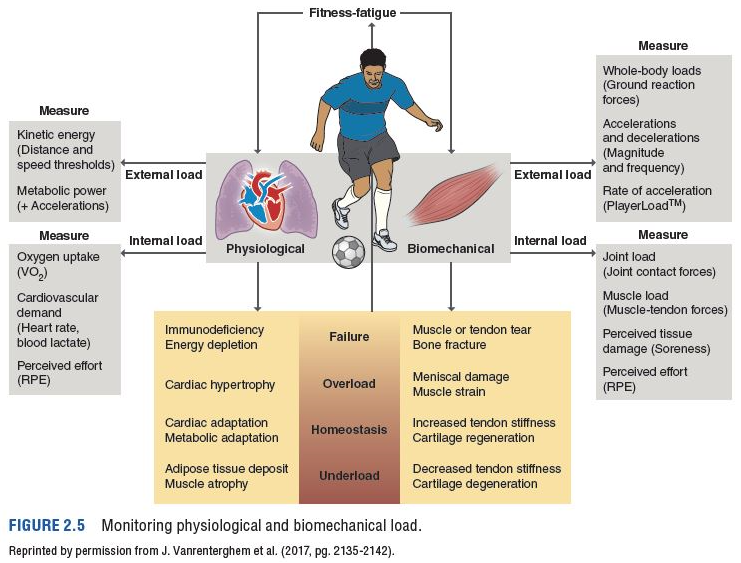Developing Load Monitoring Systems and Strategies
by NSCA’s Essentials of Sport Science
Kinetic Select
September 2023
This excerpt briefly discusses different assessments of internal and external load measures.
The following is an exclusive excerpt from the book NSCA’s Essentials of Sport Science, published by Human Kinetics. All text and images provided by Human Kinetics.
Given the extensive range of methods and variables available to practitioners for both programming and monitoring training load and fatigue, the challenge is to select measures with demonstrated validity and reliability in the specific environment of interest (113). In the applied context, validity is important not only in comparison to a criterion or gold standard measure, but also from an ecological perspective (see following section for more specifics on statistical issues in monitoring training load). Although a foundation of any monitoring system is the ability to accurately quantify the training dose (121), microtechnology provides a potentially overwhelming number of external load variables that are not all uniquely useful (133, 144). Furthermore, the development of a system for athlete monitoring should involve the quantification of training load coupled with assessing the individual response, which is then used to guide decision making regarding future training volume and intensity (35, 121). As described earlier, there are numerous options for assessing internal and external load, and sport scientists are advised to familiarize themselves with the specific advantages and disadvantages of the various measures given the context of their environment. Critically, there are very few, if any, approaches that should be universally applied (arguably perhaps apart from the routine measurement of session RPE).
External Load Measures
An important consideration in the selection of external load metrics is whether there is a conceptual justification and consistent association between any of these measures and performance or injury (see previous section and chapter 19) (121). In addition, it is important for sport scientists to ensure that external load metrics provide important and unique insight (133, 144). For example, research in field and court sports using advanced statistical approaches has allowed the identification of key parameters to quantify training and competition load (133, 144). This kind of analysis can reduce the burden on practitioners because it allows them to concentrate on only the most important metrics, which may reduce the likelihood of making a decision based on a variable that is ultimately not important (145). This should include consideration of locomotor load (i.e., speed and distance) and metrics that account for other movements (141). Finally, from a monitoring perspective, it is ultimately the response to a given external load that should be assessed.
Internal Load Measures
Although a group of athletes can undertake a similar external load, the internal response is likely highly individual (122). As addressed earlier in this chapter and covered in detail in chapters 14 and 17, there are numerous approaches to measuring internal load, including objective (e.g., HR) and subjective (e.g., RPE) methods. It is likely that a combination of these approaches, including the integration of internal and external load, will prove most useful; however, the context of the environment should be the driving factor behind the decision to use a particular approach.
General Monitoring System Components
In addition to the selection of individual variables that make up a monitoring system, some general system components should be considered—specifically, a combination of locomotive and mechanical external load and session Rating of Perceived Exertion (sRPE) (121), because it is unlikely that a single variable can capture the complexity of training and competition load (145). Figure 2.5 provides one example of a comprehensive monitoring approach (141). A fundamental requirement of a good monitoring system is that it be as noninvasive as possible to avoid adding to the challenges of the high-performance sport environment (66). Athlete buy-in is fundamental to ensure that resources are appropriately used, and the purpose of the monitoring program and its impact on training and competition need to be fully understood by athletes, coaches, and other stakeholders (66). These aspects are important because both a lack of feedback and the suggestion that training modification decisions might be unfair are potential drivers of poor compliance (103). In order to limit these possibilities, the results of any monitoring program should be clearly communicated to athletes, coaches, and other staff with a specific emphasis on individual-level analysis and the use of reporting that is both visually appealing and as easy as possible to comprehend (113). This may be partly achieved with a combination of color-coded formatting and the use of clear diagrams and figures. An important consideration for sport scientists is that there is a tendency to overvalue the importance of variables obtained from new technology (e.g., GPS) or complex protocols (particularly for the assessment of internal load) when it can be argued that subjective metrics, in the form of self-report, are as good as if not better than most other measures. Ultimately, an approach that incorporates both biological and psychological components likely presents the best methodology (66).

NSCA’s Essentials of Sport Science provides the most contemporary and comprehensive overview of the field of sport science and the role of the sport scientist. It is a primary preparation resource for the Certified Performance and Sport Scientist® (CPSS®) certification exam. The book is available in bookstores everywhere, as well as online at the NSCA Store.
- Privacy Policy
- Your Privacy Choices
- Terms of Use
- Retraction and Correction Policy
- © 2025 National Strength and Conditioning Association